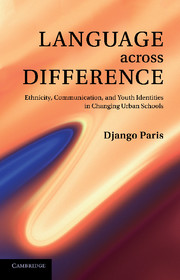Book contents
- Frontmatter
- Contents
- Figures
- Tables
- Acknowledgments
- 1 Beginnings: shouts of affirmation from South Vista
- 2 ‘Spanish is becoming famous’: youth perspectives on Spanish in a changing youth community
- 3 ‘True Samoan’: ethnic solidarity and linguistic reality
- 4 ‘They’re in my culture, they speak the same way’: sharing African American Language at South Vista
- Interlude : on oral language use, research, and teaching in multiethnic schools
- 5 ‘You rep what you’re from’: texting identities in multiethnic youth space
- 6 Making school go: re-visioning school for pluralism
- Appendix: Notes on methodology in cultural studies of language across difference
- Notes
- References
- Index
2 - ‘Spanish is becoming famous’: youth perspectives on Spanish in a changing youth community
Published online by Cambridge University Press: 05 August 2011
- Frontmatter
- Contents
- Figures
- Tables
- Acknowledgments
- 1 Beginnings: shouts of affirmation from South Vista
- 2 ‘Spanish is becoming famous’: youth perspectives on Spanish in a changing youth community
- 3 ‘True Samoan’: ethnic solidarity and linguistic reality
- 4 ‘They’re in my culture, they speak the same way’: sharing African American Language at South Vista
- Interlude : on oral language use, research, and teaching in multiethnic schools
- 5 ‘You rep what you’re from’: texting identities in multiethnic youth space
- 6 Making school go: re-visioning school for pluralism
- Appendix: Notes on methodology in cultural studies of language across difference
- Notes
- References
- Index
Summary
Along with the extraordinary demographic shift away from an African American majority and toward a Latino/a majority in the city and schools of South Vista came the omnipresence of the Spanish language. Spanish, spoken in various mainly Mexican varieties and in code-switching blends with varieties of English, was everywhere in youth space. By the 2006–07 school year, Spanish was at least one of the first languages of nearly 70 percent of the students of South Vista. This does not mean, of course, that it was the primary language used by all of the Latino/a youth at the school, though it was the primary home language for the vast majority of these students. In fact, as I will show in Chapter 4, many Latino/a youth participated heavily in AAL and struggled to maintain facility in the primary language of their parents and grandparents. We know little about how Latino/a, African American, and other youth in shifting communities and schools like South Vista think about and use Spanish across ethnic difference. It is to exploring this youth understanding that I dedicate this chapter.
- Type
- Chapter
- Information
- Language across DifferenceEthnicity, Communication, and Youth Identities in Changing Urban Schools, pp. 24 - 55Publisher: Cambridge University PressPrint publication year: 2011

